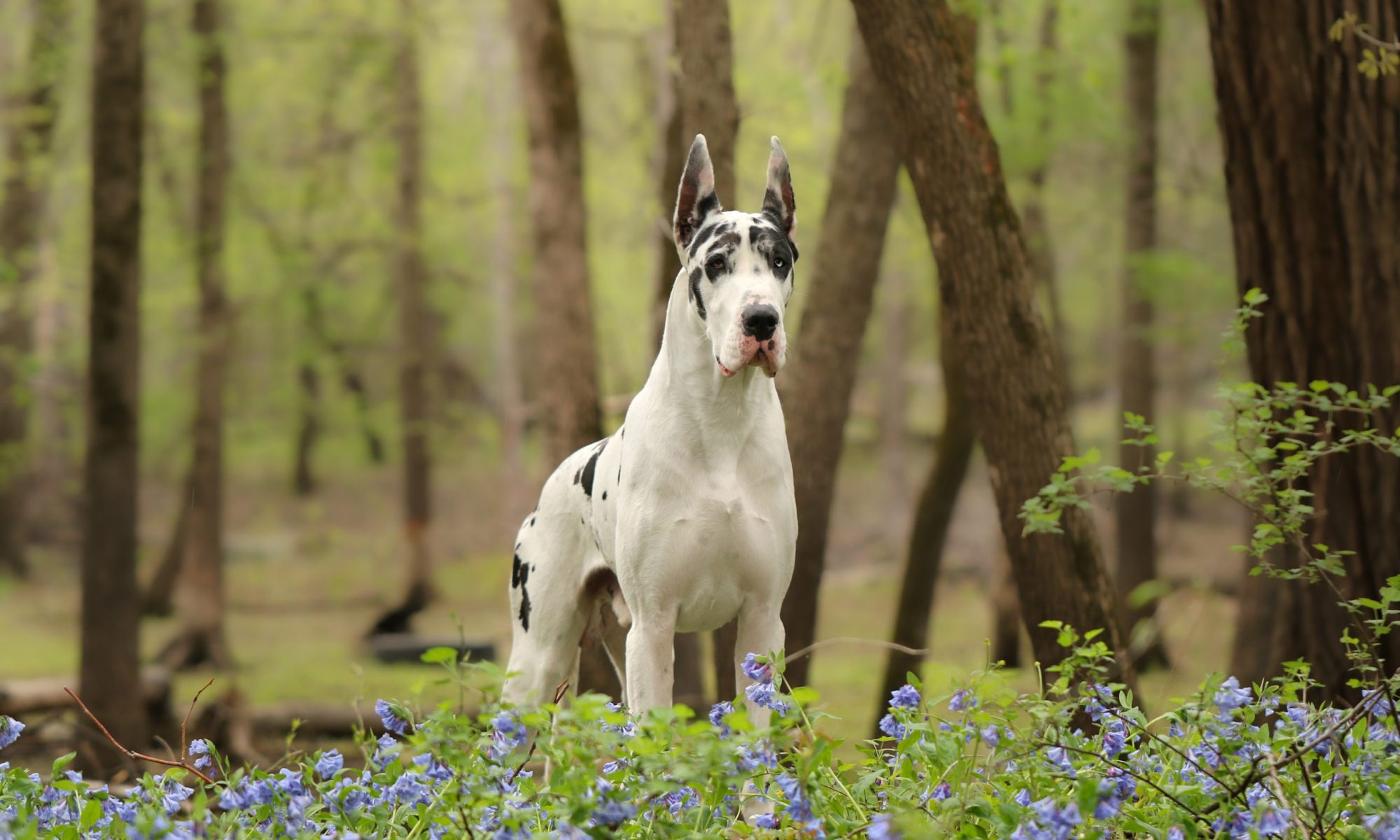Great Dane Colors
There are seven showable Dane colors: fawn, brindle, blue, black, harlequin, mantle, and merle as well as some common mismarks (any non-showable color). Please check out the breed standard (US, although the standard is very similar in other countries as well): https://gdca.org/wp-content/uploads/TheGreatDane/2021-GDCA-Illustrated-Standard-10_19_21.pdf
Harlequin – “Base color shall be pure white with black torn patches. Merle patches are normal.” What makes a harl? Genotype (genetic composition): one copy of the merle gene and one copy of the harlequin modifier gene; phenotype (physical expression): white base coat with torn patches of color.
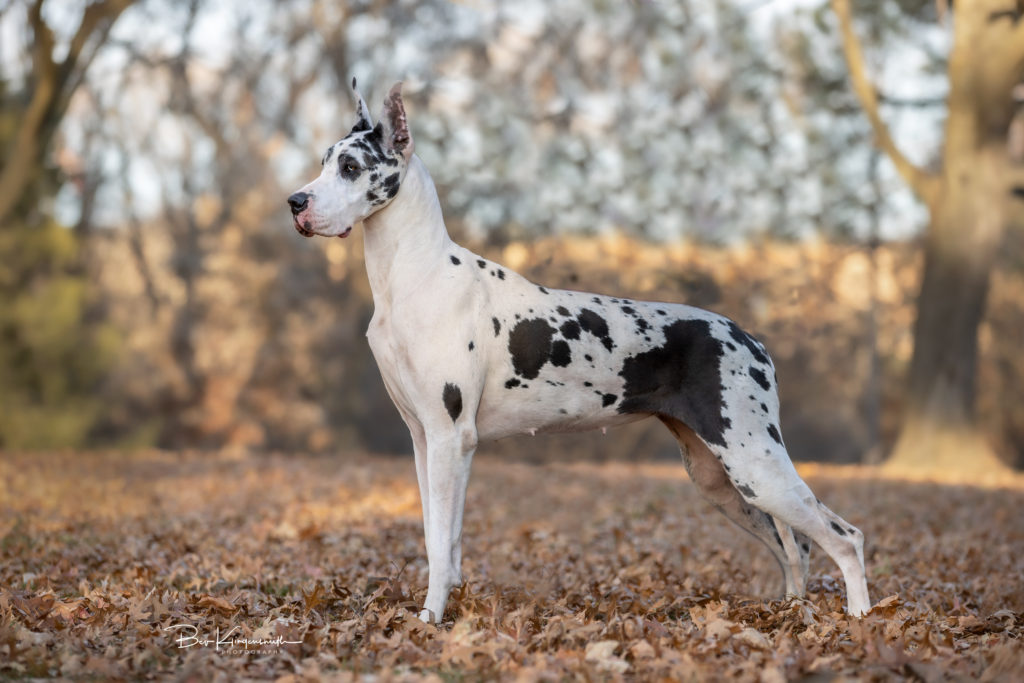
Think of harlequin like a coat with holes, which can be worn on top of other solid colors, so black (standard harl), blue (blue harl), fawn (fawnequin), and brindle (brindlequin). We desire the mantle pattern with harls – meaning the chest, feet, and neck are white, although even a heavier marked harlequin can be competitively shown.
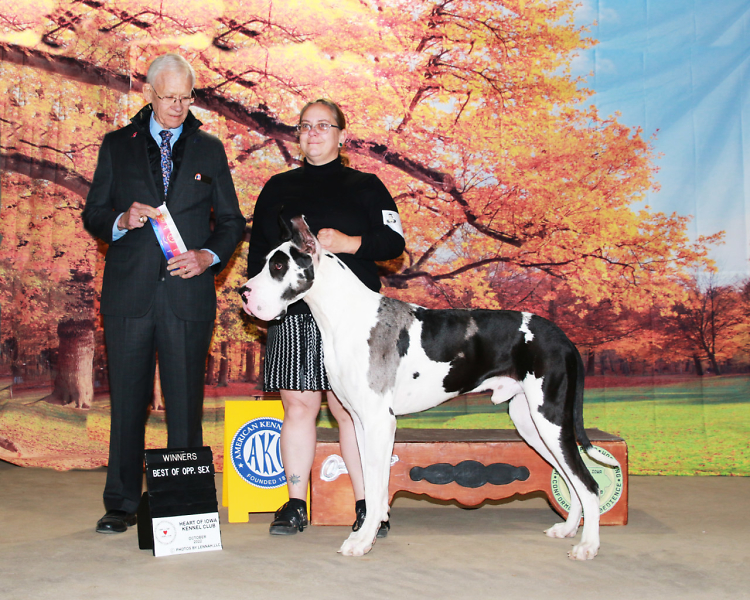
It should be noted that ALL harlequins have merle patches on them somewhere; some have a lot and some have very little.
Sometimes harls can be tricky to identify, like when they are heavily blanketed with color. Some tells would be any patches (maybe on the legs) or odd breaks of white in the color blanket. Sometimes they are very lightly marked, being mostly white. To know for certain a dog’s, we can color test. If the dog has one copy of the merle gene and one copy of the harl modifier, they are indeed a harl.
Sometimes there is confusion regarding a blue harl vs “standard” harl. To be a blue harlequin, the dog will completely lack any black pigment (not to be confused with merle patches).
A dog can carry the harl modifier gene, but without the merle gene, it is not expressed. It takes the merle gene to make the patches, then the harl modifier gene turns the gray base coat to white.
Merle – “A pale gray to dark gray merle base color with black torn patches within.” Merles can vary in shades, from light silvery to a dark gray. They’re all simply called “merle”. What makes a merle? Genotype: one copy of the merle gene (no harl gene); phenotype: gray base color with torn patches (typically black). Merle is dominant, so is displayed if the dog has a copy of the merle gene, however the gene length and how it is expressed can vary, giving us a range of how it might be displayed on the dog. The vast majority of the time, it is easy to identify, but some dogs do surprise us by appearing to be a solid color and actually having the merle gene.
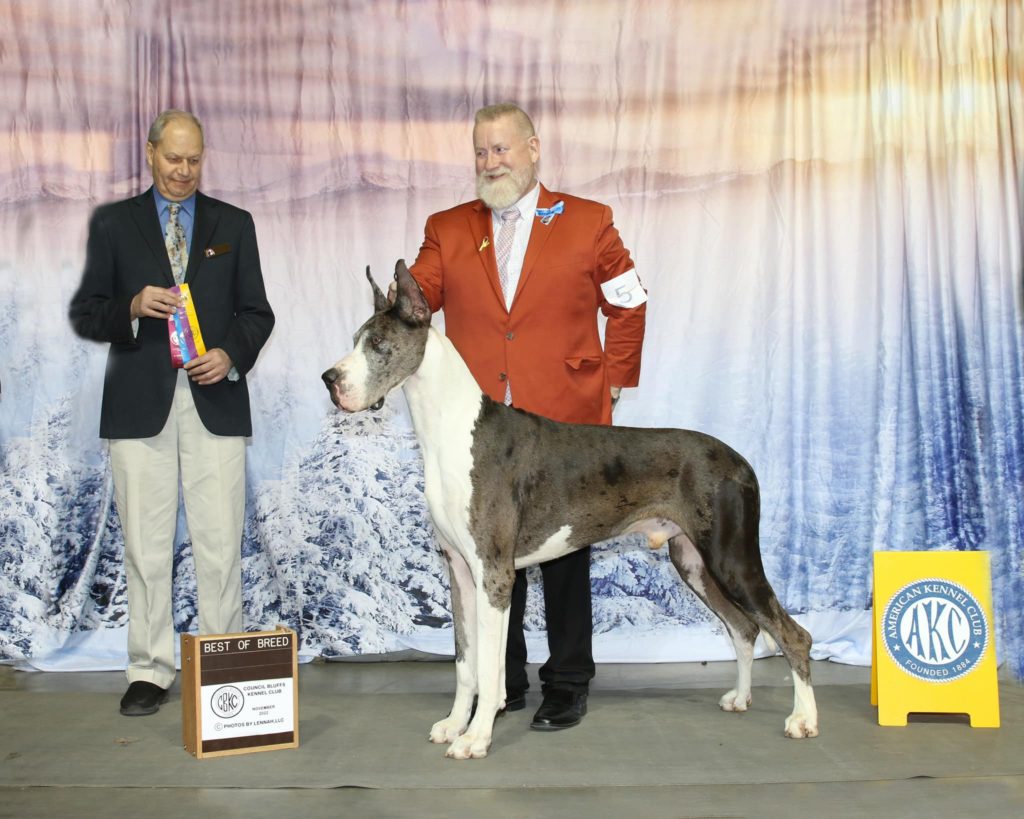
Most breeds that have the merle gene have both red and blue merles. However in Danes we only have the blue variety. Danes do have both blue and black pigment options. We could have a Dane who has blue pigment and one copy of the merle gene and that would be the Dane version of a “blue merle”. So while technically all our merles are “blue merles” (when compared to a red merle), we never denote our regular merles as such because our “blue merle” would completely lack black pigment. Again, don’t get the merle (gray) confused with the blue. A Dane is either blue OR black – if you see both “blue” and black on a Dane, it’s because of the merle gene, not the dilute blue gene.
Merle does tend to darken with age.
In addition to the dog having the dilute blue and merle, they could also be a fawn merle or even a brindle merle. In those cases, depending what other genes/dilutions are at play, we might just see the merle expressed where we’d normally see black (i.e. the black mask or brindle stripes) or we can sometimes see body patches of different shades. It’s always the merle gene giving us patches though.
Merle was the last color added to our standard and allowed to be shown. Many folks use the fact that we have added mantles and merles in semi-recent years as thought that the standard will continue to be updated to add additional colors/patterns. However, the reason merle was added is because we cannot have harlequin without the merle gene. The only genetic difference between harl and merle is that the harl has an additional “harlequin modifier” gene, which turns the gray base coat to white. So as long as we’re producing harls, we will produce merles. The same cannot be said for other colors.
Check out this presentation about the merle gene.
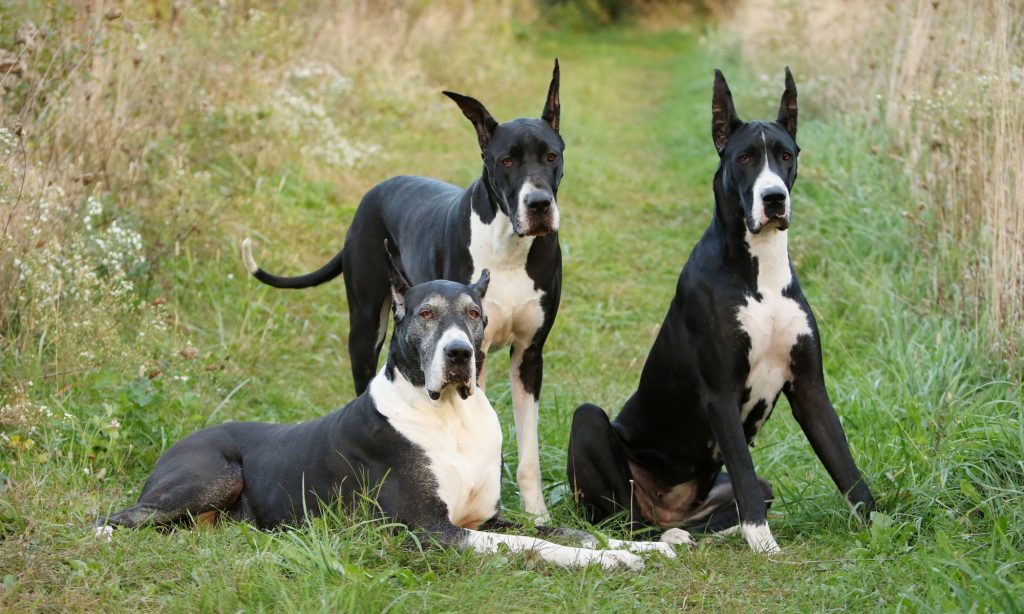
Mantle – “Black and white with a black blanket extending over the body.” What makes a mantle? Genotype: this is a recessive pattern, meaning to be displayed, the dog must have two copies; phenotype: white feet, chest, blaze on face, neck, and tip of tail. There is often confusion on a black with white and mantles. It can be a fine line, but typically it’s the amount of white (the more white, the most likely a mantle) and how it is displayed – is there at least a partial white collar? White tip on the tail? If so, most likely a mantle. Again, the dog can be color tested to be certain.
The term “mismarked” mantle is a bit overused. Any mantle whose pattern (and color) allows for it to be shown would not be a mismark, although they might not be ideally marked. Side note: before mantle was an accepted color to be shown (in the late 90’s), we used to call this “boston”.
Because mantle is a pattern, it can be applied on any color, including merle and harlequin. The mantle pattern is allowed to be shown on merles, harls, and (black) mantles. Any other color would not be allowed to be shown.
Piebald – this is not an acceptable pattern to be shown, but a common pattern in the breed. Piebald is also recessive, meaning the dog needs two copies of the gene for it to be expressed and can be produced from two parents not displaying it. Sometimes referred to as a “color headed” dog, this pattern can be applied on top of any color (harl, merle, black, blue, fawn, or brindle). The color on their head resembles the mantle pattern, but the rest of the body is mostly white, with some rounded patches of their color. Usually identified because their head has a lot of color, but the rest of the body is very white.
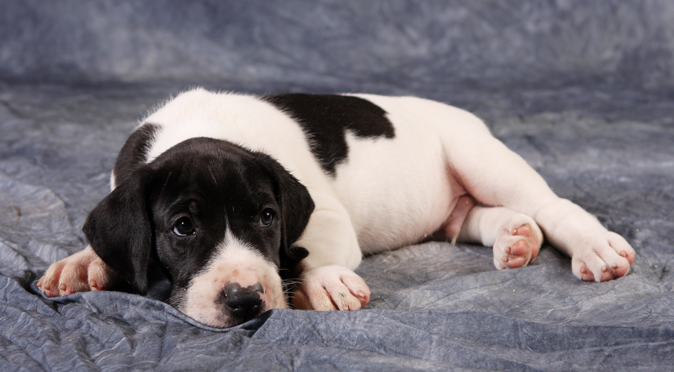
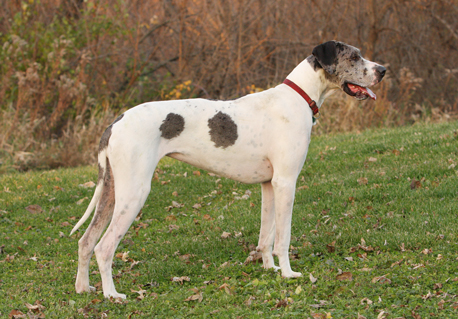
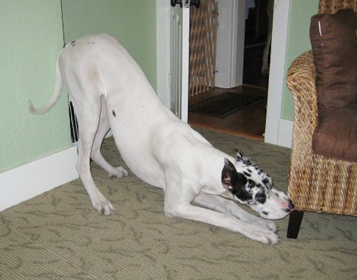
Merlequin and White (AKA double merle) – As many folks are aware, breeding two dogs with the merle gene together has a risk that the puppies might inherit a copy of the merle gene from each parent, therefore being a “double merle”. Two copies of the gene wipe out most of the color on the dog, leaving us with a mostly white dog. It’s always incomplete, so there are usually at least some black or merle patches somewhere on the dog. There are two versions of double merle Danes – those with the harl modifier gene and those without. Those without the harl modifier gene will have merle patches on them and are called merlequins (a white dog with merle-only patches). Those with the harl gene have additional gray base coat removed (that is the role of the harlequin modifier – to turn the gray base to white) and are even more white.
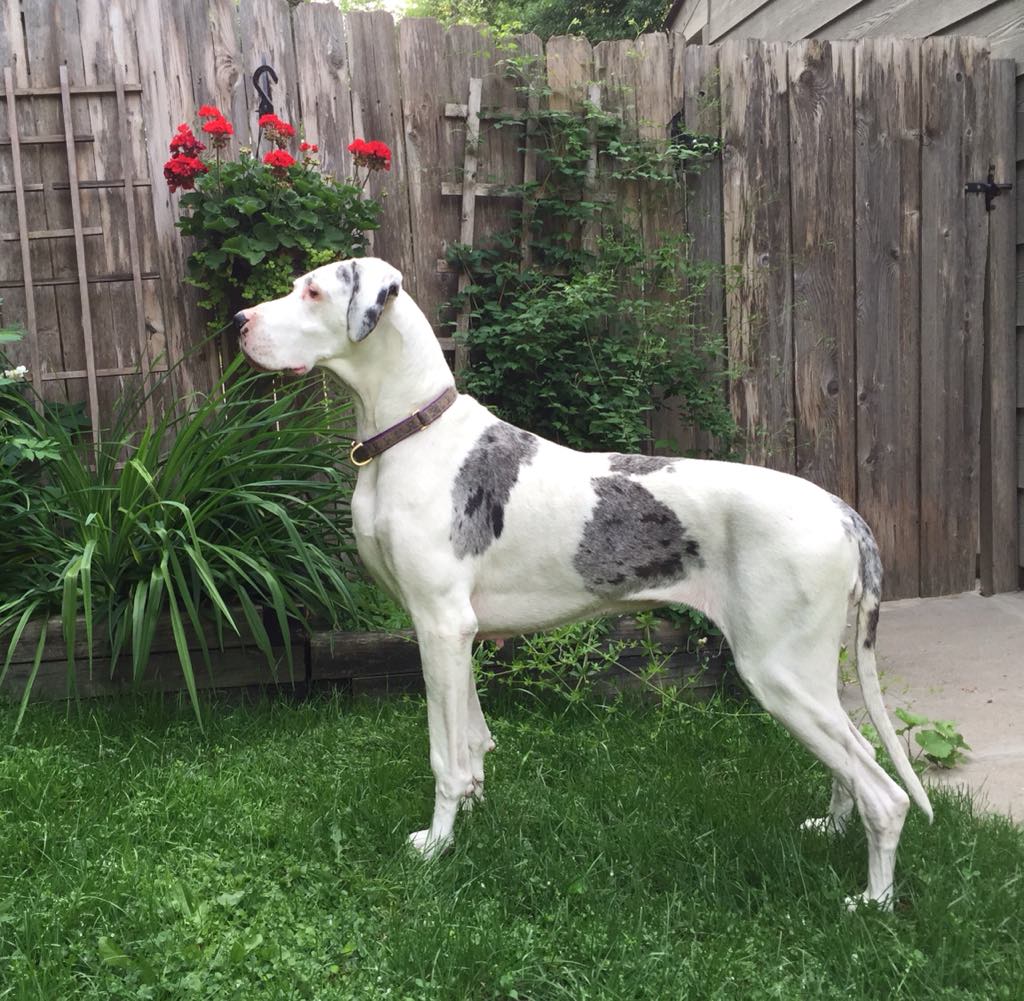
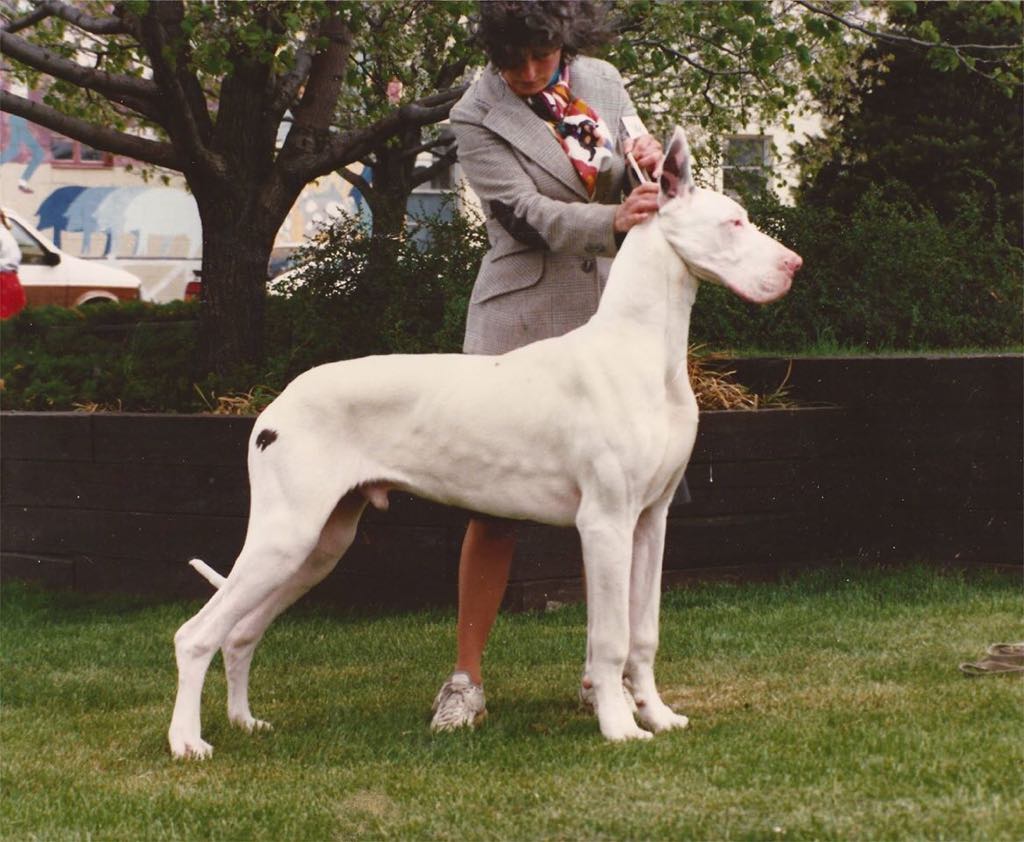
Double merle dogs can be deaf and/or blind. It isn’t because these dogs are sickly, it is merely due to the lack of pigment. Within the inner ear, there are tiny little hair-like structures called cilia, which play a vital role in transmitting sound. The lack of pigment on the cilia disrupts that process and can mean the dog is deaf or partially deaf. A BAER hearing test would be needed (once the dog is post 6 weeks of age) to determine the extent or if any hearing loss. Because we cannot see the inner ear, sometimes a dog can be very white and still have enough pigment in the inner ear to allow for hearing or partial hearing. It should be called out that any non-double merle puppy littermates are not at risk of any color related issue and will be as healthy as their pedigree allows.
There is often confusion over “merlequins” and people mistakenly think harls with merle patches (remember: ALL harls have merle patches) or mantle merles are merlequins. Just because a harlequin has lots of merle patches does not change the fact that they are a harlequin. While there are dogs that give us pause in identifying their color, we can color test to be certain.
Due to the large amount of white on most piebalds, some will mistakenly believe them to be a double merle. Not only is it not the same genotype as DMs, but pies also do not carry the risk of sensory impairments….because of all the color on their head.
Fawn – “The color shall be yellow gold.” Fawns can range from a pale color to a very deep yellow gold. Fawns should have a black mask. Like other solid colors, some white is permissible for showing.
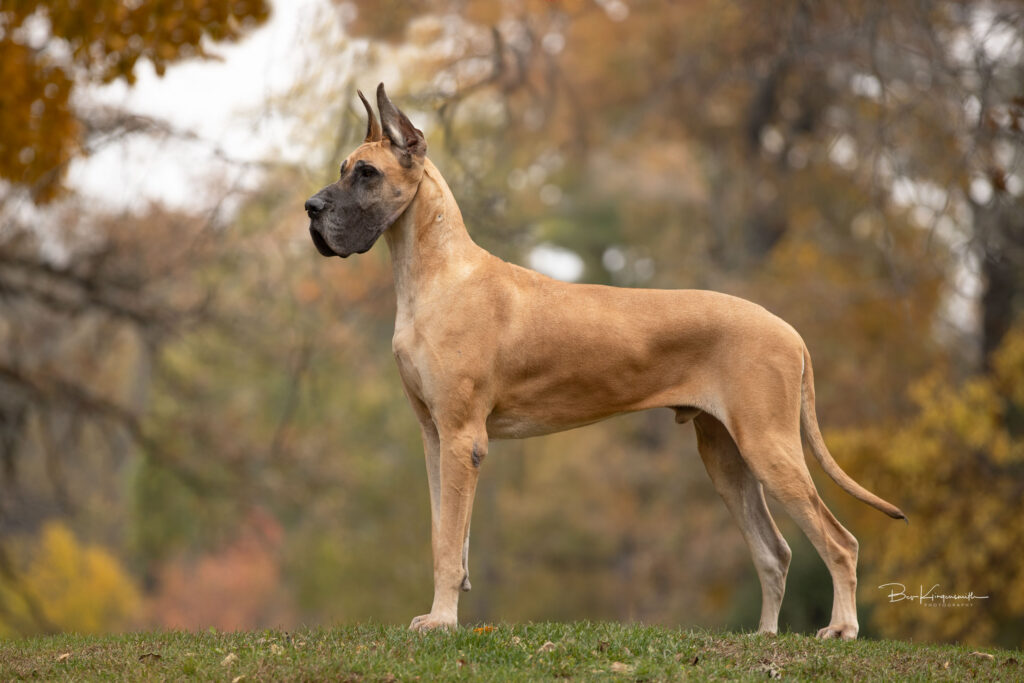
Brindle – The base color shall be yellow gold and always brindled with strong black cross stripes. The term “reverse brindle” is sometimes used to describe a dog with heavy black striping, but the dog truly isn’t a reverse, they just are heavily marked.
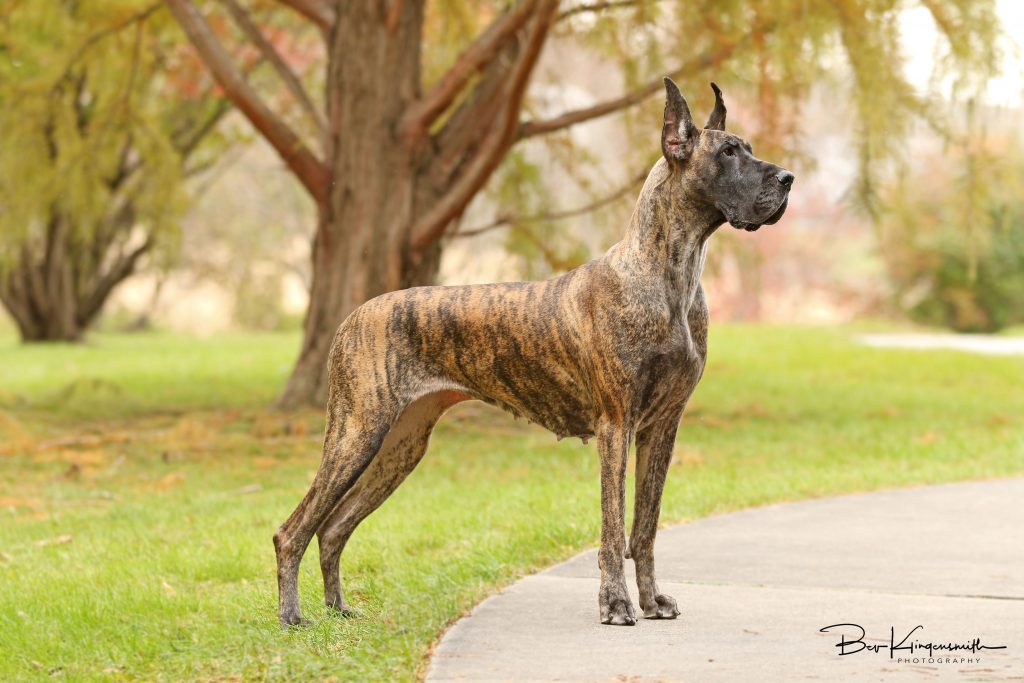
Black – The color shall be a glossy black. Some white is permissible.
Blue – The color shall be a pure steel blue. Some white is permissible.
